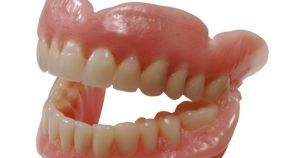 Technologies of prosthetics - constantly developing sphere of stomatology. New materials, techniques, new equipment are being developed. Visitors to the clinics are offered a large selection of methods for prosthetics and materials: acrylic plastic, cermets, metal plastic, ceramics, crowns made of aluminum oxides and zirconium.
Technologies of prosthetics - constantly developing sphere of stomatology. New materials, techniques, new equipment are being developed. Visitors to the clinics are offered a large selection of methods for prosthetics and materials: acrylic plastic, cermets, metal plastic, ceramics, crowns made of aluminum oxides and zirconium.
In this series, plastic dentures are considered less durable and not the most successful option in terms of quality. But statistics show that today, plastic prostheses occupy a significant place among the rendered dental services. Given the shortcomings, they have a number of advantages that make them in demand.
The main material for manufacturing is acrylic plastic. With the development of polymer materials, he also underwent a number of qualitative changes. The composition of the polymer has changed, the equipment has appeared, with the help of which it became possible to more accurately display the anatomical features of the human palate and jaw in the prosthesis.
Content
- materials used
- Varieties plastic prosthesis
- Plastic crowns
- Temporary prosthetics
- Methods of making
- stages of manufacture and installation
- Advantages and disadvantages
- compared to other types of prosthetics
- maintenance and repair
- is believed
- Price question
materials used
Classically known prosthesismake of dental plastic. It is light, durable and fairly hard. It is for this reason that the gum is sometimes rubbed and traumatized.
Now more modern materials, nylon and polyurethane are used. Such prostheses are somewhat more expensive, but they are softer and better adjacent to the gum.
Varieties of plastic prosthetics
In general, plastic prostheses are divided into two types: removable and non-removable.
Plastic bridges are installed when several teeth are missing, but a part of their teeth is retained. The bridge is fastened to the teeth with the help of
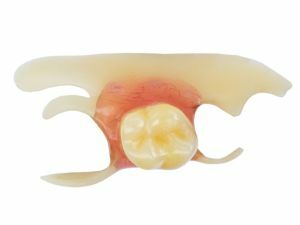
Prosthesis of a butterfly made of plastic
special devices. An anchorage wrapping a healthy itch with a wire is called a clamper. Another, not so noticeable fastening, attachment.
Code missing one or two teeth is possible fastening, which is called "butterfly".
Whole dentures or removable systems are made from acrylic based plastics. They consist of two main parts, a basis that imitates the color and shape of the structure of the sky and gums, and the artificial plastic teeth themselves.
Removable structures to the gums are attached due to the vacuum suction effect. As an additional fixation, you can use special creams.
Plastic crowns
By appointment, the plastic crowns are divided into temporary and permanent crowns.
A non-removable plastic crown is not the best solution for teeth mounting on an ongoing basis, since such products quickly wear out 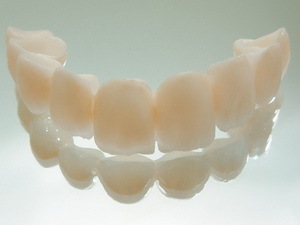 .This is especially true of chewing teeth.
.This is especially true of chewing teeth.
After a certain period of time, the plastic changes its color and will differ from the color of the natural tooth. When the crown begins to deform, the remainder of food remains in the submerged part, a negative bacterial flora is formed.
But due to the affordable price and the fast way of manufacturing, many people, in the hope of later replacing them with more durable, put temporary plastic crowns.
Temporary prosthetics
Plastic prostheses are indispensable for temporary prosthetics.
When are they used:
- Most often plastic teeth use as an option for temporary prosthetics of for further installation of ceramics, cermets and other types of prosthesis. The technology takes some time to make these kinds of crowns. To ensure that a person does not experience discomfort and does not walk with sharpened teeth and black holes, put temporary plastic bridges and crowns.
- When installing and implanting implants .While the pin engrafts it cover with a plastic crown.
- If at the time of prosthesis it is not possible to establish a permanent crown for medical reasons( periodontal disease, inflammatory processes in the oral cavity, loosening of the teeth, etc.).
Methods of manufacturing
Plastic teeth are manufactured in two main ways: pressing and casting. In terms of quality, casting dentures are considered to be the best, in view of the fact that this method more accurately copies the shape of the jaws and gums. Consequently, the habituation is more rapid and the soft tissue of the gums is less injured.
The most common plastic prosthesis is the elderly, suffering from adentia( loss of teeth).Either clients of clinics who for some reason have lost part or all of their teeth.
Prosthetics take place in a close relationship between the prosthetic physician and the technician who makes the prosthesis.
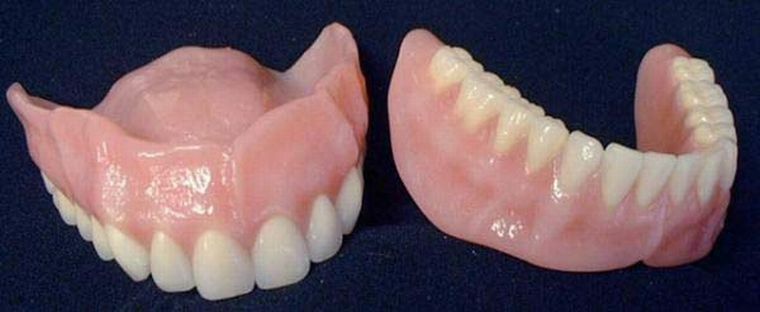
Stages of manufacture and installation
Stage preparatory:
- the doctor first examines the oral cavity for contraindications, then X-ray;
- in the presence of teeth that can not be restored, they are removed;
- if there are tubercles and tumor formations on the gums, perform alveollectomy( removal operation);
- doctor determines the anatomical features of the structure of the face and mouth, selects the shape and color of the teeth, determines how the design will look;
- the impression of teeth is removed.
Stage of manufacture: 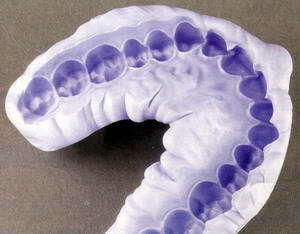
- technician models with an impression and a series of sequential actions an individual model of the jaw;
- a wax prosthesis is made with teeth, at this stage the first fitting is being performed;
- , based on the fitting, corrections are made to the wax version of the model;
- is then replaced with acrylic in a special cuvette, the mass is polymerized;
- the finished workpiece is ground and polished;
- is the second fitting, if the prosthesis is approached and no defects are found, it is installed.
In this way, plastic prostheses are made by cold casting.
Compressive pressing uses a slightly different technique, but the sequence of operations is maintained. The first and second methods are based on three-dimensional modeling of the oral cavity, the shape of the gums, and bite.
Advantages and disadvantages of
Advantages of using plastic for removable prosthetics:
- has a wide range of shades of color that correspond to natural;
- to them quickly enough get used, if well adjusted;
- new materials less injure the gums.
Disadvantages:
- fragility, from 3 to 5 years;
- change color over time;
- can rub the gum and irritate the mucosa;
- particles of food fall into the prosthesis, therefore it is necessary to look after the oral cavity regularly.
For people who have lost teeth, plastic prostheses, this is the best option in a financial sense, and in terms of expediency.
Comparison with other types of prosthetics
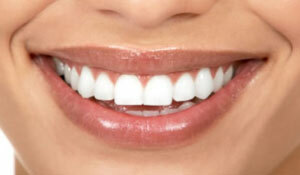 Winning in price, plastic prostheses are inferior to cermets, ceramics and other materials. First of all, in strength and durability. Prosthetics based on metal frame structures and ceramics by quality indicators and durability significantly exceed plastic prostheses.
Winning in price, plastic prostheses are inferior to cermets, ceramics and other materials. First of all, in strength and durability. Prosthetics based on metal frame structures and ceramics by quality indicators and durability significantly exceed plastic prostheses.
On average, they are given a guarantee of 10 to 15 years. But in fact, the service life can be longer. In addition, they do not change color, they look like natural teeth. This is manifested not only in the color of the teeth, but also in brilliance and the ability to reflect light.
In the manufacture of crowns, the technician together with the prosthetist performs almost jewelry work. After all, the shape of the jaw, the size and shape of the teeth in each person is strictly individual, so the main goal is not only to restore and protect the teeth, but also to give the prosthesis a maximum aesthetic effect. The main task is to make the smile beautiful, and the teeth shine, but at the same time look natural.
Repair and care
Plastic removable dentures require quality care. They need to be removed and cleaned. Can be slightly abrasive toothpaste. Disinfect with special pills.
Removable designs from acrylic plastic are fragile enough, from impacts even on the bottom of the sink can crack and break. They are erased, cracks are possible. Do not despair, dentures are repaired and restored.
Plastic removable systems, even after all the fitting steps, still non-ideal adjacent to the gums. Therefore, to avoid the 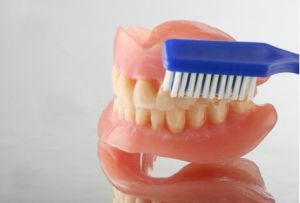 rubbing the gums and fix the removable system better, use a fixative glue. For example, Korega and Lakalut. At the same time, remember that their fixing capabilities lie within 12 hours.
rubbing the gums and fix the removable system better, use a fixative glue. For example, Korega and Lakalut. At the same time, remember that their fixing capabilities lie within 12 hours.
If the denture changes color or if a plaque appears that you can not handle on your own, contact your dentist. You are restored and the prosthesis is cleaned.
At night, you can not remove the removable system, especially during the period of habituation and adaptation. In the future, artificial teeth can be removed at night and stored in a dry form. Rinse is recommended after each meal.
There is an opinion of
About plastic removable dentures and temporary crowns made of plastic, you can find a lot of reviews of a different nature.
A resident from Lyubertsy writes that as a result of a trauma in a ski resort on a top five she developed a cyst. Over time, the tooth had to be removed.
I did not want to grind healthy teeth and put crowns. Therefore, I decided to put a plastic prosthesis with a "butterfly" fastener. I wear 4 years, cost 1700 rubles. Now the color has changed a little, I will change for a new one, from the same doctor.
Alina, Lyubertsy
A retired woman writes from Novgorod.
My children persuaded to put removable bridges. A little collected itself, the rest of the money the children gave. A good doctor got caught. Now I'm no longer a toothless old woman, I quickly got used to it, I do not even take pictures again for the night. She began to feel more confident and more often to smile.
Marina Petrovna, 58
Price of the issue
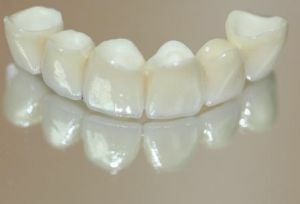 Price for a prosthesis of 6 teeth starts from 3000-4000 rubles, an average of 10,000 rubles will cost one plastic bridge. But each case must be considered individually and in a complex. Before deciding on the choice of the clinic, it is advisable to visit it and get acquainted with the price, materials that are used, customer references.
Price for a prosthesis of 6 teeth starts from 3000-4000 rubles, an average of 10,000 rubles will cost one plastic bridge. But each case must be considered individually and in a complex. Before deciding on the choice of the clinic, it is advisable to visit it and get acquainted with the price, materials that are used, customer references.
Although plastic prostheses are not the last discovery in the field of prosthetics, they remain in demand. Despite the fact that acrylic plastic inferior to other materials for prosthetics, due to its availability, simple installation procedure and a good aesthetic effect, it is popular.
